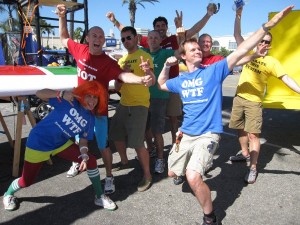Microsoft's Phoenix takes flight (maybe)

Update 21-Aug 6PM PDT: Carl reports: "Regarding Windows Project Phoenix at #Flugtag: let's just say it was the worst Windows crash I've seen in a long time."
Microsoft's Ben Rudolph (@BenThePCGuy on Twitter) contacted me earlier this week with a tantalizing invitation. Microsoft had an entry in an offbeat contest in Southern California. Did I want to come check it out? I couldn't make it, but fortunately, my Windows 7 Inside Out partner Carl Siechert is based just a few miles up the road and braved the Metro Rail crowds on Friday for a look at the preparations. Here's his report:
You might’ve heard earlier this week about the reappearance of Microsoft Flight (formerly Flight Simulator). In totally unrelated news, another Microsoft team plans to take flight in Long Beach, California, later today.
A group of engineers and product managers from the Redmond giant (shown below) have assembled an aircraft to compete in the Red Bull Flugtag—an event in which vehicles are launched off a 30-foot-high pier into the harbor. Windows Project Phoenix appears to be one of the saner teams in the competition, which includes themed flying machines ranging from the Flintstones to the Jetsons. Other notable entries feature President Obama (with Dumbo-sized ears), M.C. Hammer, a baby-laden stork, and a giant sombrero.
When word went out several weeks ago on an internal e-mail list, program manager Brian Lysak jumped at the opportunity to participate. His experience tinkering with a souped-up Audi, motorcycles, and sailboats gave him some engineering know-how that helped develop the craft’s center module. It forms the core of the Windows airplane, which consists of a long wing decked out in Windows colors. But his real value to the team became evident when team engineers began to wonder where they could get some carbon fiber material, and Brian volunteered “I’ve got some in my garage!”
While many Flugtag (“flight day” in German) entries are decidedly low-tech, the Microsoft engineers took this project (somewhat) seriously. They immersed themselves in the details of wing design, material strength, and construction techniques—all while working late into the night fueled by Red Bull. Team member and PC evangelist Ben “The PC Guy” Rudolph estimates that team members put in about 1500 hours on this project. Although Microsoft Corporation is supportive of their efforts, team members continued to work their regular day jobs, albeit bleary eyed. The Phoenix relies on a blend of space-age materials; the wing consists of carbon fiber and Macrolux wrapped in Monokote. On the other hand, the launch tower, which is intended to give them a height advantage over the competition but might just accelerate pilot Ali Driesman’s plunge into the Pacific, is made of sewer pipe and milk crates.
When he’s not working on Windows Project Phoenix, Lysak works with hardware OEMs to develop systems that offer the best Windows experience. For example, he worked with Dell on the Latitude Z, the ultra-thin and light 16" laptop. “The [PC hardware] product cycle totally applies” to Phoenix development, he enthused when I spoke to him Friday. “It has to be light, cheap, and easy to assemble.”
So what about the software side? I asked Rudolph (better known as The PC Guy) if this project bore any similarities to Windows development. Same thing, he said: the program manager starts by outlining the big picture, and then it’s an iterative process of refinement.
There is one key difference, however: the Phoenix has never been tested. There was no widespread beta, or even a single test flight, as this craft is designed to fly only once. Despite this lack of feedback, Lysak predicts with great confidence that the length of the flight will be somewhere between 0 and 300 feet.
Who knows? If Windows Project Phoenix (which is not listed in Mary Jo Foley’s CodeTracker) does well, it might show up in Microsoft Flight. Or not.
For more images, see this ZDNet Photo Gallery.
